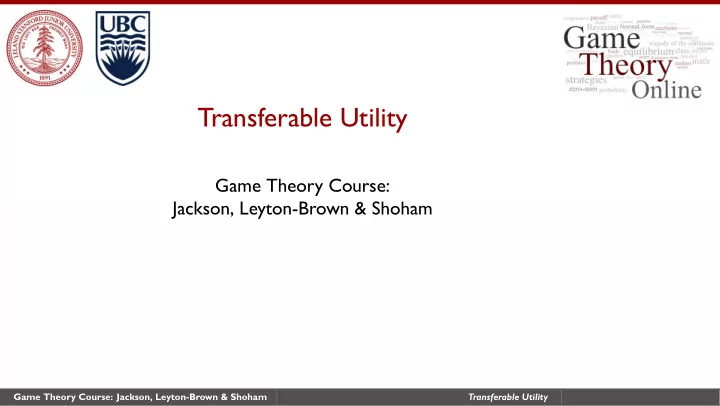

Transferable Utility Game Theory Course: Jackson, Leyton-Brown & Shoham Game Theory Course: Jackson, Leyton-Brown & Shoham Transferable Utility .
. Transferable Utility . Definition (Quasilinear preferences with transferable utility) . Agents have quasilinear preferences with transferable utility in an n -player Bayesian game when the set of outcomes is O = X × R n for a set X , if the utility of an agent i given joint type θ can be written u i ( o, θ ) = u i ( x, θ ) − p i , where o = ( x, p ) is an element of O , and u i : X × Θ �→ R . . Game Theory Course: Jackson, Leyton-Brown & Shoham Transferable Utility .
Implications: is not influenced by the amount of money/wealth an agent has agents don’t care how much others are made to pay (though they can care about how the choice affects others.) . Transferable utility mechanisms • When outcomes consist of basic outcomes and some transfers or payments: u i ( o, θ ) = u i ( x, θ ) − p i • We can split the mechanism into a choice rule and a payment rule (or transfer rule): • x ∈ X is a “nonmonetary” outcome • p i ∈ R is a “monetary” payment (possibly negative) that agent i makes to the mechanism Game Theory Course: Jackson, Leyton-Brown & Shoham Transferable Utility .
. Transferable utility mechanisms • When outcomes consist of basic outcomes and some transfers or payments: u i ( o, θ ) = u i ( x, θ ) − p i • We can split the mechanism into a choice rule and a payment rule (or transfer rule): • x ∈ X is a “nonmonetary” outcome • p i ∈ R is a “monetary” payment (possibly negative) that agent i makes to the mechanism • Implications: • u i ( x, θ ) is not influenced by the amount of money/wealth an agent has • agents don’t care how much others are made to pay (though they can care about how the choice affects others.) Game Theory Course: Jackson, Leyton-Brown & Shoham Transferable Utility .
. Direct Mechanisms in a Quasilinear Setting . Definition (Direct mechanism) . A direct mechanism (in a quasilinear setting ( N, O = X × R n , Θ , p, u ) ) is a pair ( x , p ) specifying a basic outcome x ( θ ) and a profile of payments or transfers p ( θ ) = ( p 1 ( θ ) , . . . , p n ( θ )) . . Game Theory Course: Jackson, Leyton-Brown & Shoham Transferable Utility .
. Private Values (Conditional Utility Independence) • Preferences have private values, or satisfy conditional utility independence, if each agent i ’s utility function can be written as u i ( o, θ i ) : • it does not depend on the other agents’ types • An agent’s type becomes their valuation function: i ’s value for choice x ∈ X is v i ( x ) = u i ( x, θ i ) • the maximum amount i would be willing to pay to get x • Alternative definition of a direct mechanism: • ask agents i to declare valuation functions v i : X → R • Standard notation: ˆ v i is the valuation function that agent i declares Game Theory Course: Jackson, Leyton-Brown & Shoham Transferable Utility .
Recommend
More recommend